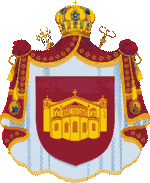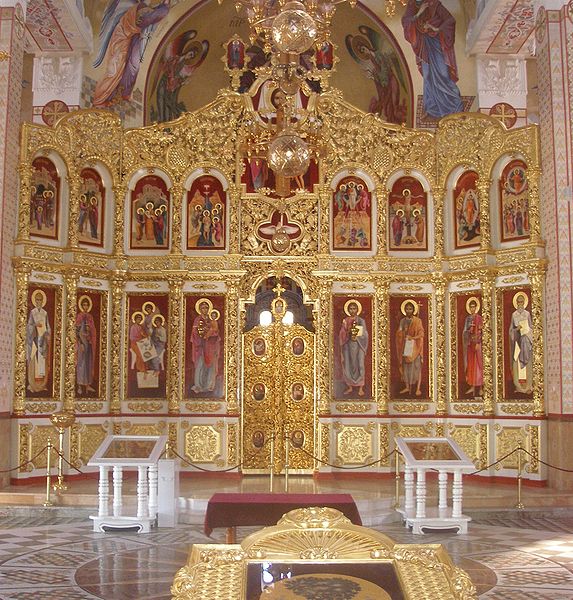Life of the Macedonian Orthodox Church
CENTURIES - OLD PROCESS
Translated by Vesna Stevkovska
*Macedonians are a biblical people with a great
Christian spirit, with faith, hope, and love toward their
Church.
In the last several decades the Macedonian Orthodox Church (MOC) was, is, and most probably will be the topic of discussions, polemics, arguments, and even attacks by church institutions of the neighbouring countries and beyond, who are trying to prevent and postpone its joining the family of equal orthodox church organizations. In doing this there are attempts to deny the historical canonical foundations of the entire life of the Macedonian orthodox church. A large part of the propaganda and media has been engaged in pressuring, isolating, and negating the MOC and its legitimate existence. The aim of this is to distort and suppress historical facts from the past and present, with the aim of bringing into question the basic characteristics of the Macedonian orthodox people, its church institution and its truth as a nation that has existed for centuries, has retained their orthodox belief and for almost six centuries has had an independent, sovereign state, the Republic of Macedonia.

Similarly, it is as though certain circles and individuals of the orthodox churches of the neighbouring countries have forgotten their own process of attaining independence and right to their own national orthodox church. The eight-century long presence of the Ohrid Archiepiscope whose centre represented Christians from every part of Macedonia from its establishment until its illegal closure, is being suppressed. They are suppressing centuries-long movements of the Macedonians in the XIX and XX century for revival of the Ohrid Archiepiscope, which disputes the continuity of this institution before the MOC as legitimate representative of all orthodox believers in Macedonia and the entire Macedonian people in the Diaspora.
It is a fact that even now, after international recognition of the Republic of Macedonia and its being a member of the UN organization, authocephalousness of the MOC continues to be negated. This could easily be regarded as an attack on the Christianity of the Macedonian people. For this reason it is necessary to emphasize, together with the historical truth of the Macedonian people, the canonical and historical foundations of the MOC, and its continuity as part of the world cultural treasury. For more than a millennium, the MOC, as the Ohrid Archiepiscope, has lived spiritually in the deeds of its protector, Saint Clement of Ohrid. In the IX century he opened the ways for a cultural revival of the Macedonian Slavs, who had migrated to Macedonia towards the end of the VI century, where they met with the Christian natives, and whose Christian beginnings are linked with the missionary activities of St. Apostle Paul.
The work of the brothers St. Cyril and Methodius from Salonika and their accomplishments were many times enhanced and multiplied by their most distinguished disciples, St. Clement and St. Naum in Macedonia, in their shrines, churches, and schools along the coast of Lake Ohrid. Literacy, based on the south Moravian speech, and the books translated into the first all Slavic literary tongue were saviors to the entire Slavic people, and European culture as a whole. St. Clement of Ohrid was elected as first Slavic episcopate, while his Velichka eparchy in Macedonia was the spiritual Christian foundation on which Macedonian Slavs could establish their church hierarchy. Thus, through his spiritual school in Ohrid and the 3,500 students, St. Clement of Ohrid educated the people in Macedonia and beyond, while toward the end of the Xth century even the Russians were converted through the Cyrillic holy books.
Tzar Samoil established his state on Macedonian land, with Capitals in Prespa and Ohrid, leaning mostly upon Macedonian Slavic ethos, organizing his own spiritual and autocephalous church organization. Nevertheless, for almost two centuries the great diocese of the Ohrid Archiepiscope, inherited from the time of Samoil, had been retained within the boundaries of the Byzantine empire.
Later, during the time of Byzantium and under Bulgarian and Serbian rule during XIII and XIV centuries, the Ohrid Archiepiscope enjoyed the reputation of one of the leading and oldest orthodox church institutions in the Balkans. Even well educated Ohrid archiepiscopes of Greek descent showed highest respect for the missionary moves of St. Clement and St. Naum, and toward their tutors St. Cyril and St. Methodius. Their monasteries along the coast of Lake Ohrid were regarded as the greatest shrines in this archiepiscopal town, because this was the resting place of these saints and teachers’ relics, while inside them traditions of the founders of the Ohrid church were cherished. Hence, the archiepiscopes of Ohrid left behind inspirational writing devoted to St. Clement of Ohrid, praising him as their spiritual father.
Throughout the Middle Ages and the time of the Turkish empire Macedonians expressed their spiritual and intellectual potentials through the activities of the Ohrid archiepiscope. Cherishing of church literature, architecture, and all types of art related to iconography and liturgy, has been highly evaluated in world science, confirming once again that works of the highest artistic standard at their time were created in Macedonia, thus enriching not only the Macedonian but also the world treasury of art and culture.
The centuries-long Christian life of the Macedonians, since the time of St. Clement and throughout the long history of the Ohrid Archiepiscope, until the time of the renaissance in the XIX century, contributed toward the creation of artistic masterpieces with universal significance, exceptional esthetic value, and deep humane message. Thus, numerous significant works of art which the human race can be proud of, were created in these churches and monasteries.
The icons from Ohrid, frescoes from St. Sofia, Nerezi, Kurbinovo, and Nagorichani, architectural forms, constructors, and works of applied art, have been included in every anthology of important achievements of the time. These works are an illustration of the original characteristics and features related to Macedonian cultural tradition and they represent a major contribution to Slavic and Byzantine cultural and spiritual relations.
Macedonia is the cradle of iconography of Slavic teachers and the presence of several hundred portraits of St. Clement and his contemporaries. This is sufficient evidence of the cultural continuity of Macedonian tradition since the oldest of times until the present day. A question which raises itself is this: why is the presence of these saintly apostles of Slavic literature not as emphasized in other nations as it is in Macedonia? The answer would be because their activity took place among the Macedonian Slavs, and because their work became part of their life and faith throughout the centuries.
Macedonian spiritual space was never closed. Instead, Macedonian priests, writers, and artists were always part of the noble humanist currents based on Christ’s learning and the traditions of St. Clement’s church. Included among the specific occurrences in cultural history in Macedonia are the ornamental decorations, as well as glagolic and Cyrillic transcripts from the Ohrid school created in Kratovo and Slepche during the period of X - XVI century.
Many Macedonian artists also gave their contributions to the neighbouring Balkan institutions. Thus, Christopher Zhefarovich from Doiran, is the most distinguished artist in the development of art in Serbia during the XVIII century. Similarly, the great constructor, Andreja Damjanov, from the Veles area, had been invited throughout the Balkans to carry out sophisticated church constructions. The wood carvers from Mijak also enjoyed the reputation of leading masters in the Balkans for quite a long period of time.
A specific construction and art culture was established in Macedonia even after the closure of the Ohrid Archiepiscope, especially during the struggle for the church school communities to have service in their church Slavic tongue. Hence, across every Macedonian land hundreds of churches were constructed of Macedonian stone, Macedonian timber, Macedonian tiles, with a Macedonian heart and soul. Most often these churches have monumental dimensions and a basilical shape so as to remind of the magnificence of the old church glory. The period of renaissance in Macedonia also brought a specific iconography in orthodoxy, with special emphasis on Slavic Macedonian saints, their hagiographies and to Slavic literacy in the Balkans.
All of the above is evidence of the large contribution of the Macedonians to the cultural and spiritual development of orthodoxy in the Balkan and world art treasury. For this reason, the Macedonian orthodox church and the Macedonian people express their concern over the alleged special rights of some neighbouring orthodox churches over the ancient Christian Macedonian churches. It is difficult to believe that the constructors, icon painters, and authors of church books, present on Macedonian land for centuries in the past, are now being declared non-Macedonian. It is a surprising fact that within the long presence of feudal rulers during the XIV century, the church founders’ gifts and personal contributions, the renaissance and restoration of older churches from the early Christian, Slavic, and Byzantine period, are being declared as foreign.
Church monuments in Macedonia were true holy places which brought together Christians from every Balkan country in the world. This is why even today Macedonians protect these with the most modern scientific methods, and take care of these constructions which are constantly open and accessible to every well intentional believer, to those who respect and study them from every part of the world, while the craftsmen and donators communicated through these structures according to their spiritual virtues. Macedonians have never treated the works of their craftsmen in other countries, as their own, but rather as a natural circulation of the cultural values, good, and religious relations among Christian and other believers.
Macedonians built spiritual and cultural shrines with a strong will, love, and belief in orthodoxy. In order to survive in this region of the Balkans, for about ten centuries the Macedonian orthodox nation helped each other with the other Balkan nations and beyond that, offering a Christian hand, hence surviving slavery, assimilation, prosecution, and injustice. It has survived and will survive until the end of time, for as long as the world keeps turning, because the Macedonian people are a biblical nation with a great Christian soul, faith, hope, and love for their church.